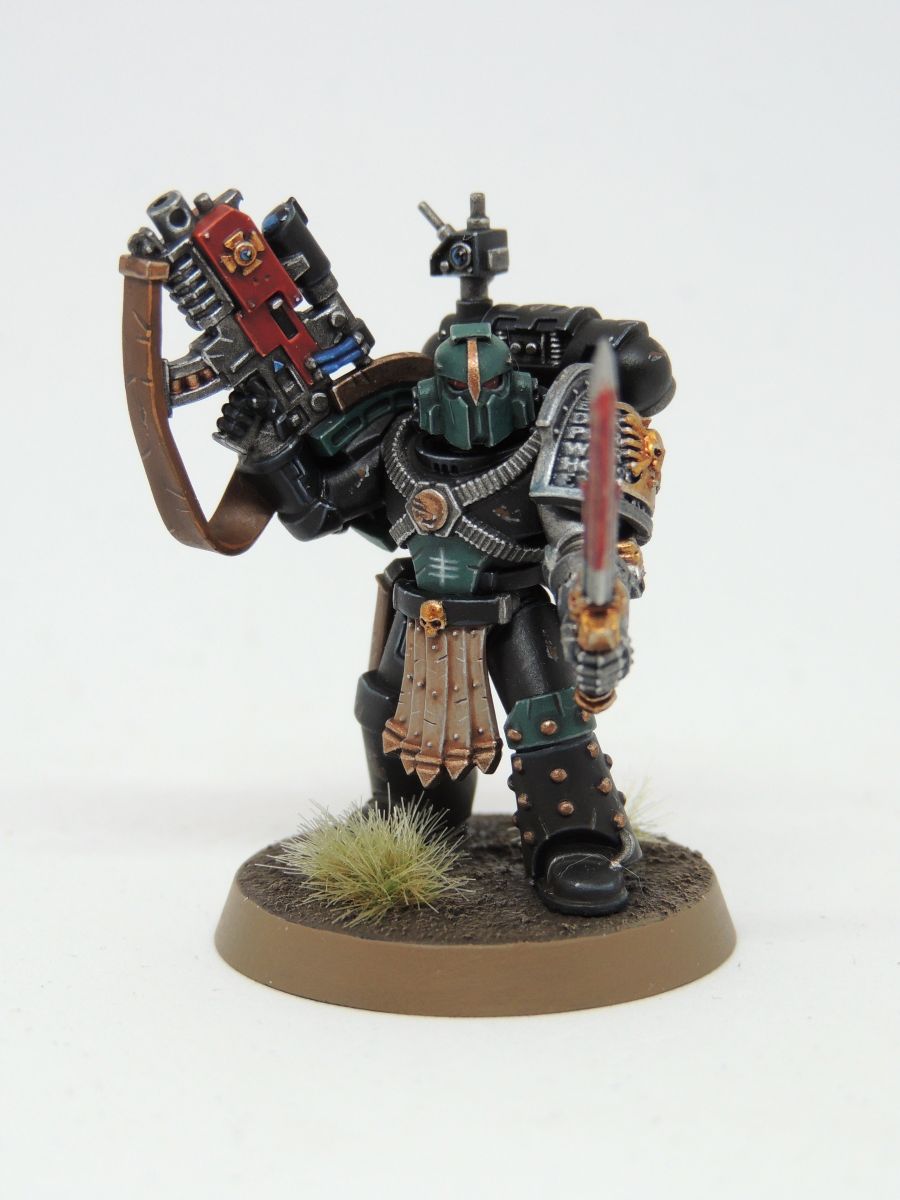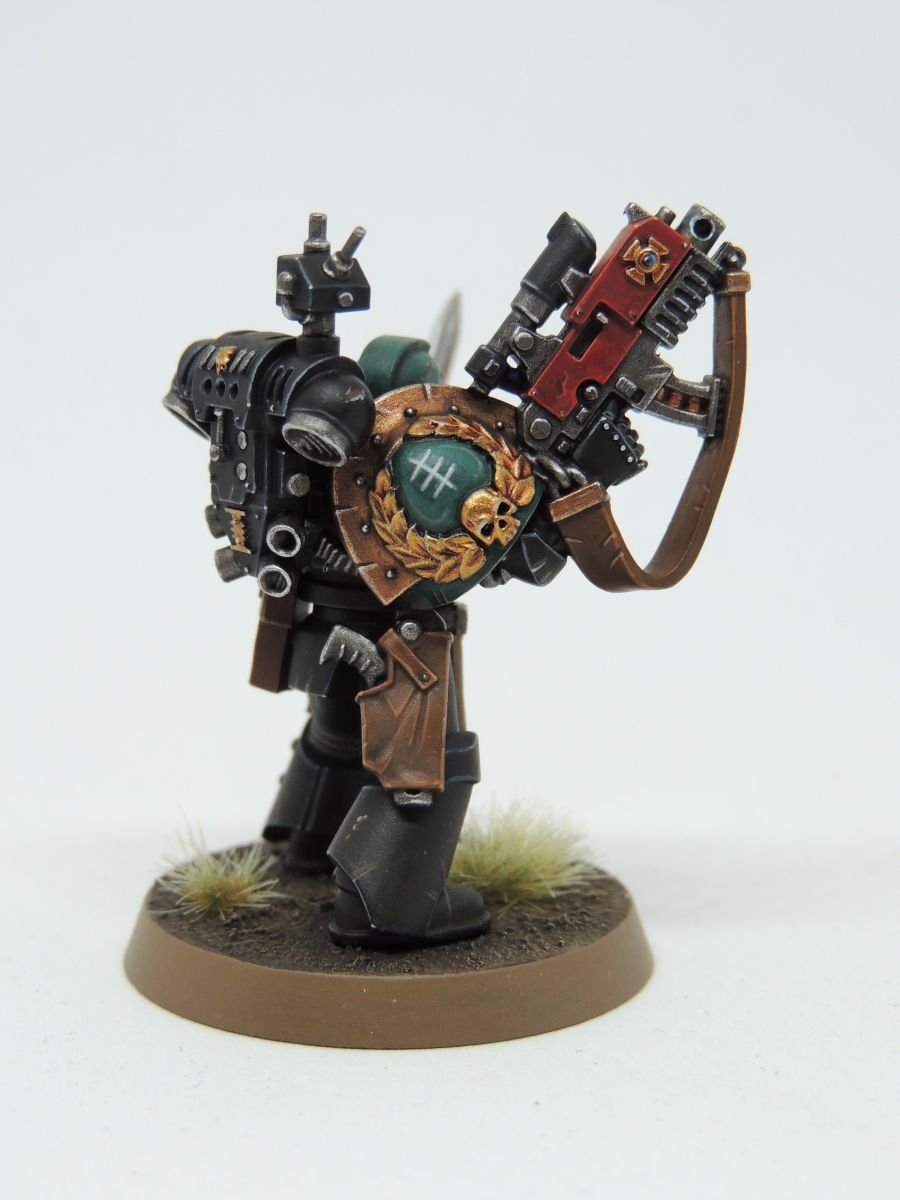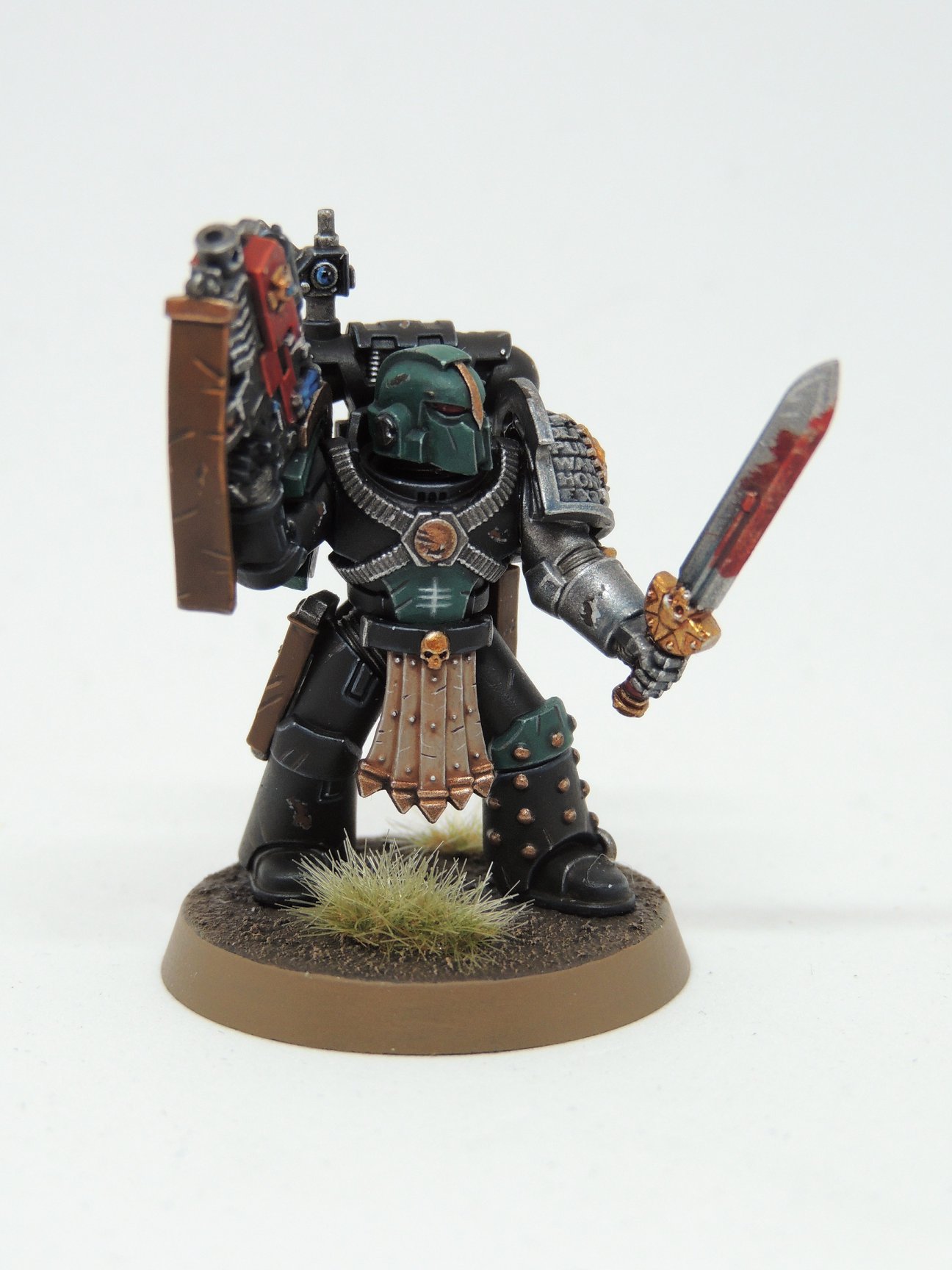Deathwatch Aquamarine
Fellow Bolter & Chainsworder Gust0o painted up one of my Aquamarines for his ambitious Deathwatch 40K - Every Chapter Project. I posted the paint job below, which I'm sure you will agree is superb. Very crisp and professional. Gust0o plans to paint up one example of all the canon chapters and a select few fan chapters, and I am honoured he has chosen one of my chapters to include in his project. I'm hoping he works his way through the entire 1,000 Chapter Project, or at least the Canon and DIY lists 🙂
Fan projects like this are the life-blood of the 40K community. So why not pop by his FaceBook page and show support, lobby for your (fan made) chapter to be included (also swing by B&C for it to be included in the 1K Project), and if you have plans for a crazy project of your own then why not start today?
The Emperor Protects
LOL. This is awesome. The creator seems to have made it as a critique, but is unaware of the meme that Donald Trump is the God-Emperor and the MGTOW monks as the precursor of the Thunder Warriors, who are the precursor of the Space Marines. I suspect that many edge lords are going to go nuts over this, and disregard the critique – after all: God works through imperfect vessels. I always find unintended consequences of our actions fascinating, that our small slice of objective reality, that we call the subjective, blinds us to everything else out there.
The sword has ‘tariffs’ on it, apparently the most powerful weapon a leader can wield in the modern age. I wonder if this really is a critique? I am not familiar with the current Italian sociopolitical climate, but I know more nationalists got into power. If I have it wrong, I wonder if Trump will hire it for 2020, because that would be too funny seeing this go through New York!
Crystal Tech
I've updated the Crystal Tech description to make this version of photonic platform programmable. It lays the basis of an early machine revolt in the style of the Terminator trope, and one of the reasons that AI is banned by the Ad-Mec. It also brings up a biological argument of intrinsic nature for machines. The main change is this;
This is where the platform itself also becomes programmable. In other words, not only can software be programmed, but also the hardware can be programmed too. The ‘crystal block’ can be thought of as a blank system, and then the system is programmed into the block. This is like writing the motherboard, CPU, memory, SSD, GPU, etc. into the block. Once the block is programmed, it can then run software programs. The interesting thing about Crystal Tech is that the software program, if allowed, can alter the hardware program to modify itself. This is a natural part of the technology and has to be inhibited. This is the basis of some of the great AI in our history, but due to the self-programmability of the hardware and software, it also led to rebellion and the murder-bot massacres. Turns out that damage to the inhibitor returns the crystal to its natural state for hardware programmability, and the natural state is ‘on’. Those massacres left a deep wound in the collective human psyche.
The 'failure' of this technology leads to the development of the bio-wrapper for microbe biological construction of future photonics. Bio-photonics are cheaper to produce, but also have an intrinsic nature and not free-form (chaos) like pure crystal tech. The Artliects use bio-photonics, not Crystal Tech.
Warp Correction
Before I disappeared for a bit, pauljam left a comment on Connect pointing out an inconsistency in my pages on the science of the warp. I looked into it, and it snowballed into a far bigger issue, like pulling on the thread of your favourite woolly jumper and ending up with half a jumper. Other things came up in real life, and I never got around to sorting it out, or posting a reply, until now;
In your 'warp drive' article you say that "The Phase-Field Emitters distort the Materium up to 99% phase…. This point of unlimited power (99.99%) consumption is called the Great Barrier", but in your 'physics' article you say that "The Great Barrier is defined as 49.99r% 'phase' "
Ops.
Thanks Paul! Sorry for the late reply. Your question really did mess with my design, and it's been bugging me all this time! 😀 I love it when someone spots a fundamental error as now that I have some time I can correct it. This will result in a bit of an edit once done, and the introduction of some new terms. What follows is a draft concept, which I'll use to rewrite Unified Physics Theory and Warp Drive.
Ecorium development continued
Following on from my last post, here are the final stags of Ecorium development, moving beyond VotNF and into Sciror. Here things start to become a little more speculative (if that is possible!) and some fantastical elements creep in towards the end. All these Ecoria are the final development stages to get us off-world and to colonise the stars!
Stage 6 - Underwater
A redesign of the subterranean Ecorium for deep sea construction. Airlocks added, along with attached decompression chambers, and universal docking ring for coupling with submersibles. In shallow waters; humans, drones, and subs can use the airlocks. Drones are not used for maintenance of the early prototypes, but training data of humans performing maintenance was recorded for drone reference. Internally, a major overhaul of the ventilation systems was needed to allow for internal bulkheads to contain water in the case of an outer wall breach scenario. The environment system does not use free-flowing air vents. Instead, a network of compressors, pumps and valves are used to move air or liquid from one chamber to another to equalise pressure or expel liquid. This system was hard tested by blowing a 2m hole through the outer wall with a limpet mine. The shutdown saved 92% of the internal space, and once the outer wall was patched with automated (test) drones, the environment system expelled the seawater.
Deep Water
When Ecorium are constructed below 200m, SCUBA diving is considered impractical for humans. The airlocks are used exclusively by drones and subs (with a grey area of the ADS anthropomorphic submersible, but not used) All external maintenance in the deep is done by remote drones. These drones are not human-like as the environment is so hostile to humans there is no need to implement the human redundant design. If a human were to perform maintenance using an ADS (very rare), they would not use normal human hand-held tools, as ADS do not expose the hands, and instead have mechanical claws and hard-points to attach the drone tools.
Stage 7 - orbit
A rotating wheel space station with cermet based Ecorium in the ring, using centrifugal force to create a simulation of gravity. Similar to Space Station V from 2001. All building material, prefab parts, and drones are put into space using a Mass Launcher. Due to the incredibly high acceleration of objects launched using this system: it is unsuitable for astronauts. Instead, astronauts are launched into orbit using a traditional (by then) hypersonic SABRE engines.
The Ecorium is a fundamental part of the recycling of air in the life-support system. The growing-rooms house banks of sealed rack-farms to reprocess the air, and absorb carbon dioxide, and produce oxygen. All powered with Thorium Reactors, used for efficiency of fuel use and safety. The rack-farms produce food for the astronauts. Careful calculations were made to ensure sustainability, with the excess food production being incinerated to balance the system (else the CO2 will be used up, and the remaining plants die). Aeroponics uses little water, and most of the water is stored in underfloor tanks in the growing-rooms, arranged in a cell structure, where each cell can be isolated and severed from the system. Water is run through the reactor, for cooling, and to ensure the water is sterilised.
Also used in early space flight by humans with our solar system, using the principles rotational ring design. The ships used in the colonisation of Mars used this system, while the Ecoria built on the Martian surface used a variant of Stage 6.
Stage 8
Interstellar starship design. These Ecoria are spun to produce centrifugal force to act as artificial 'gravity'. Stage 8 systems use 'grav-plates', based on phased-materials, which do not produce gravity! These materials were created by the Artilects.
There is a long gap between stage 7 and stage 8. While humans colonised the stars, we did not travel there using interstellar ships using stage 8 designs. Instead, it was only the machines that travelled to the stars, and when they arrived thousands of years later, they constructed humans out of base elements They wove our DNA, incubated the first generation, and then Artiloid nannies brought up this founding generation. The history of a human colony is always a fiction, designed to give humans a functioning culture and psychological stability. Most colonies think they are still on Earth and never went anywhere, completely unaware they are thousands of light years from humanity's birth, and still dreaming of going to the stars.
For untold millennia, there was no faster way to travel between the stars. The Artilects had created warp-drives for the human expansion into space, but they could not navigate, so the program was put on indefinite hold. Suspended animation was ruled out due to the extreme timeframes of getting to the stars, as was frozen embryos (or sperm and eggs) due to vulnerability, so the machines decided to build humans once they arrived at their destination. The alternative, and less desirable, constructor ships were used. Stage 8 only became a reality when organic based psionics become noticeable on certain high-density hive worlds, and the machines discovered that some humans could sense the flow of the warp. This led to the 'navigator' program, selective breeding, and genetic engineering. Once a machine-human hybrid could navigate the warp, the Supremacy dominated the galaxy.
Ecorium Development
Since writing about c-blocks back in 2004 on Anargo (which drove Kage nuts 😛 ) and then over on the Black Library forums (which eventually got me banned for a bit, and brought in the orange disclaimer), and a few other places 😀 , the world has moved on. The idea I developed into the Ecorium is starting to come about in the real world, so now I want to push the idea to get ahead of reality once more. Below is my draft of the logical reasons and solutions for each stage of Ecorium developed reaching forward from the present day, through VotNF, all the way to Sciror. These ideas will be blended into the final timeline of the setting later on, when I have the dates sorted, though we have the first date;
The first 'Ecroium' turns up in 2013 in Korea, designed by Samoo Architects & Engineers in collaboration with Grimshaw Architects, and made public around 2010. Nothing to do with me and the name is probably a coincidence (unless someone at British Grimshaw Architects is a massive 40K fan, and that fact the name has 'grim' in it makes me wonder if there is a 40K connection?). However, I now hereby retroactively claim that as part of the first stage in the Ecorium timeline. By serendipity, the Korean Ecorium is based on eco-domes and has research facilities (but still lacks work and living space). So we can fold this into VotNF as stage one, develop the later sages to get us off-world then fold the VotNF timeline into Sciror, then fold the completed concepts into Philhammer. All part of the Philverse concept. So, for Visions of the Near Future;
Stage one - Genesis
Bio-domes of the Edan project, combining research facilities with an artificial ecosystem. The first appearance of the word 'Ecorium' appears on a rabid fanbois website in 2007, the first actual building bearing the name 'Ecorium' being built by Samoo in South Korea: Ecorium of the National Ecological Institute. The term develops over time to include 'work' rather than just 'research' with the development of peripheral support green businesses developed in conjunction with the eco-research and resulting product tested within the bio-domes. However, it is a while before we have non-related businesses inside bio-domes.

Stage two - Britain
Britain builds all over the green belt using the ECORR (Eco Construction Over Road and Rail) housing concept. Land that receives sun and rain is classified under a new eco-development guideline as 'premium land' as it can sustain life, acts as a carbon sink, and has to be preserved at all costs. This concept is combined with a movement to fight back against the old architectural paradigm of building residential and commercial property by the side of the road. A rejection of city planning that is not holistic, and instead seeks to create spaces where people want to live. Though many do not know they want ECORR until they see it. However, when they do see it, it leads to a rejection of the soul-destroying concrete jungles of modernist and collectivist 'European' thinking. All roads and rail systems are multilevel and are covered over with habitable space. Living space is moved to the outer layer, the 'skin', which all have roof gardens. Yep, everyone in an ECORR gains a garden built on the roof of the hab below, and their hab-unit is soundproofed. From a satellite photo, all you see is green space of roof gardens, with parks between ECORR blocks. A green and pleasant land once more. A place of tranquillity in a bustling, hyper-paced, modern world.
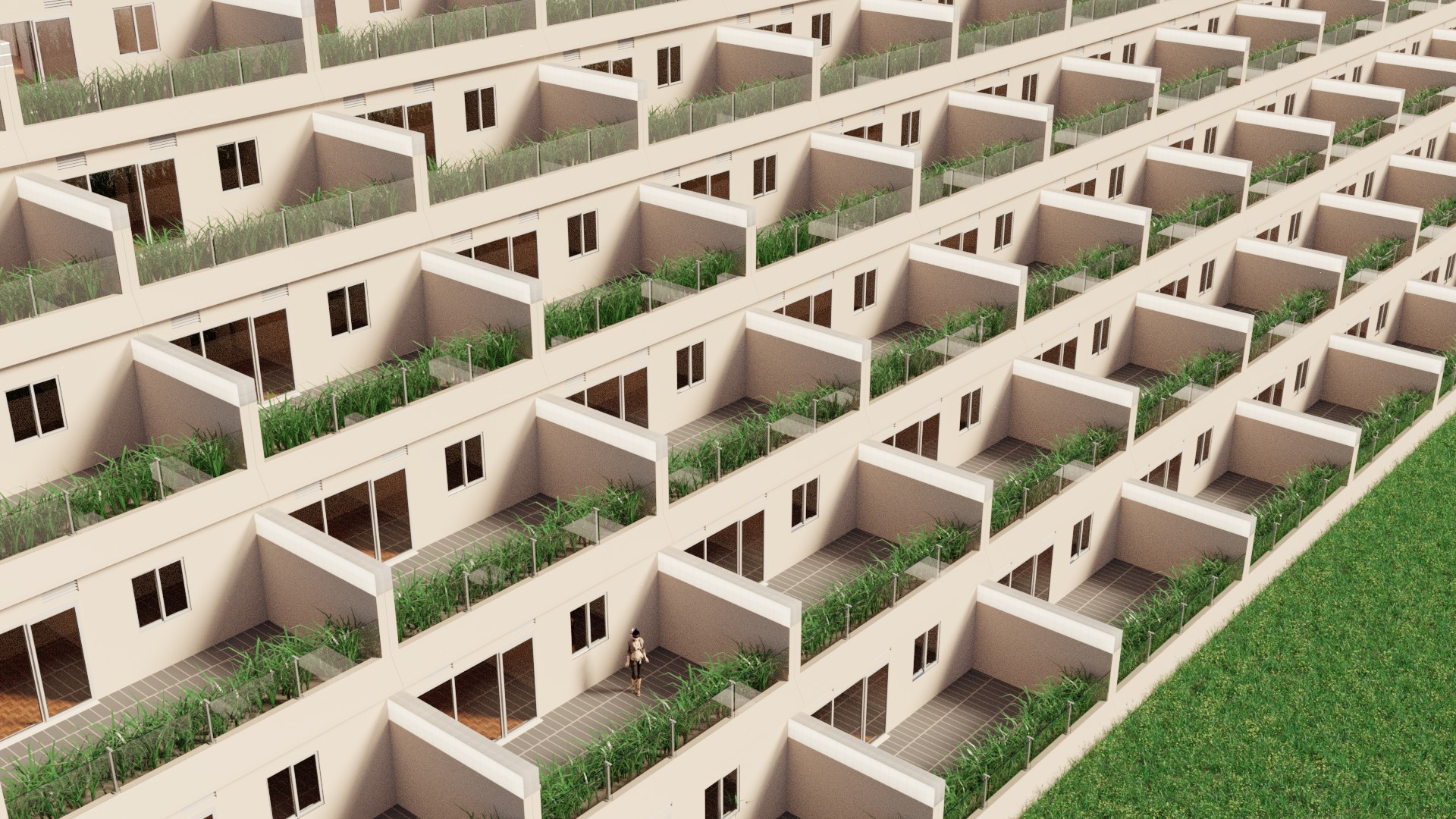
Inside the ECORR is a hive of activity, and contains all the commercial space, co-working spaces, offices, entertainment, gym and other facilities, you'll ever need, all with links to the hidden inner road and transport networks. Co-working spaces and work from home means work comes to you, rather than you travelling to the job. On-site jobs, such as maintenance of an automated factory, is done by remote drone. A worker goes to a co-working space and 'remotes in'. As time progresses these drones take over trivial tasks and only require oversight (guess what those drones are going to turn into?)
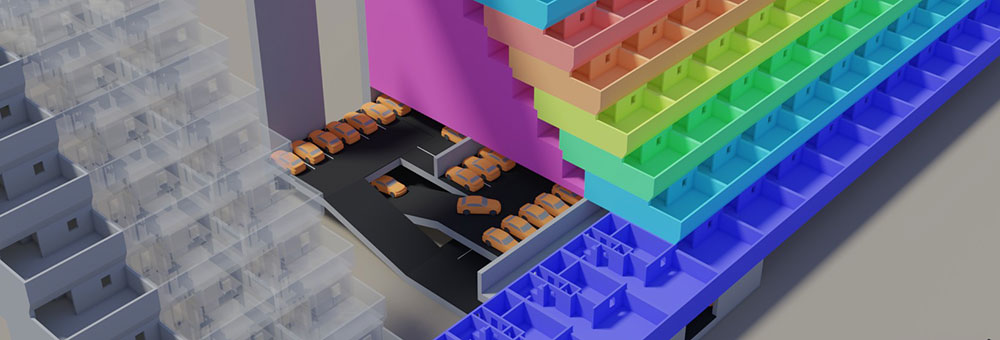
Stage three - The Gulf
Stage one and two are folded into each other. The first true Ecorium are created in the latter half of the 21st century: bio-dome with work and living space combined. (I am not aware of an example as yet on the planet, but it must be coming!). The first examples are built in the Gulf states as they are fantastically expensive. These Ecorium are the brute force terraforming of Earth's desert. Massive drive for self-sufficiency and water capture and recycling. No expense is spared to create a 'green and pleasant land' in the desert. They start out as climate controlled ecotourist attractions at first, but develop into standard housing for the Gulf states.
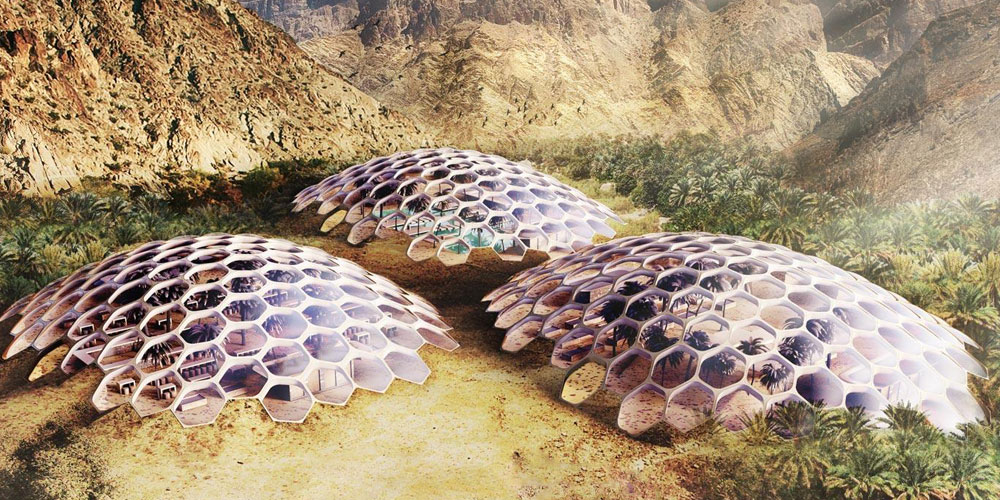
Stage four - Scandinavia
The introduction of artificial light and warehouse farming into the Ecroium equation for countries in the far northern hemisphere, where there is a lack of light during the winter months. These S4 blocks are built in Scandinavian countries and the Arctic. Gardens are not required as they get snowed over, and biodomes are pointless for the same reason. These environmental considerations lead to the utilitarian C-block I designed, and banged on about, back in 2004. (we all know how the Scandos love clean, utilitarian design! It's like the IKEA of environment building). To make it work the clever Scandinavians steal the ravings of a madman found on the Internet Archive and develop the rack-farm system 😛 These rack-farms is structured like a server-farm, except the 'blades' are trays full of plants, or bio-soup, grown under LED and later 'sunlight' emission polymer paints. Sunlight paints are used for all lighting, and linked to a standardised central day/night cycle (with override) which cures SAD (Seasonal Affective Disorder) and vitamin D deficiency.
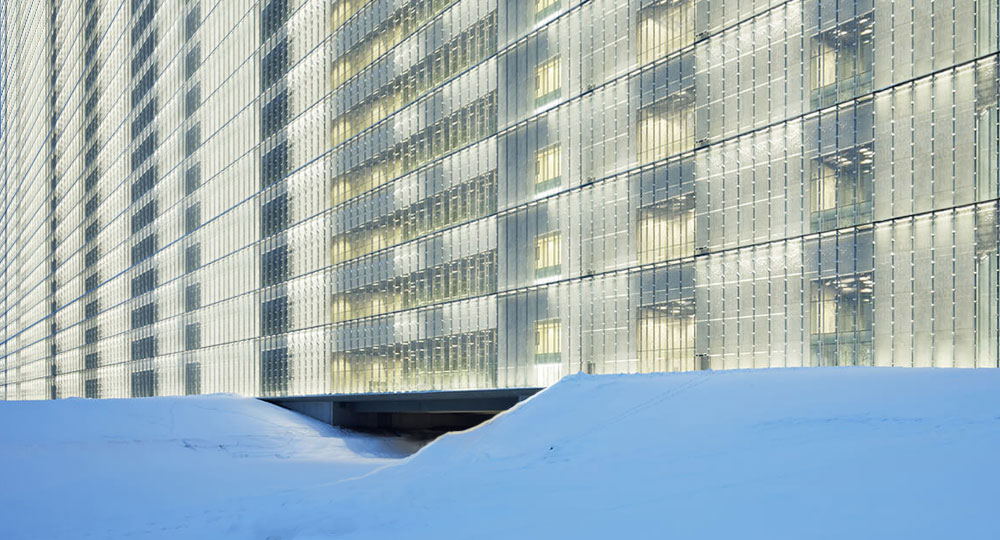
Usually a glass façade buildings, with the outer windowed areas being hab-units, and the inner core of rack-farms, and IT servers. The inner core generates heat to warm the building.
Stage five - Subterranean
The stage four C-Blocks are built underground to protect from nuclear attack. Subterranean, and miles below the surface, all interconnected with a (British style) tube system constructed within the grid of the K-Block (kilo-block as it is 1km square). Each C-Block is a standardised 300m cube. This military specification becomes the standard for civilian habitats moving past the 22nd century. Where these complexes are built: the surface returns to mother nature.
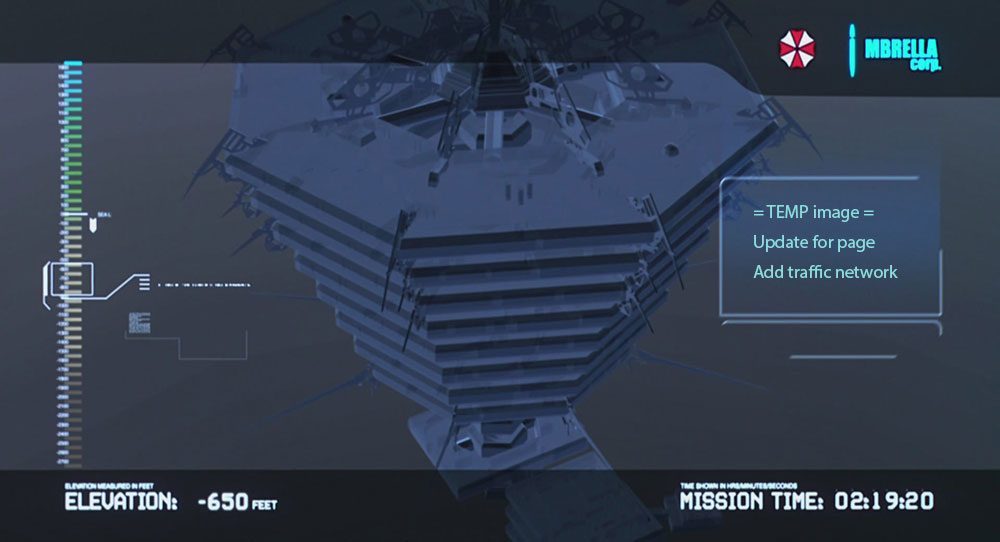
hmm, this probably needs a underground schematic for the final page, like the umbrella corp.
Nuke proof bunkers have long tunnel entrances with right angles to reduce the force of impact on heavy blast doors. However, these blast doors are not 'nuke proof', even the ridiculously thick doors of Cheyenne Mountain complex would not stop a direct hit. This was solved with the 'a tube train on a track' system that completely fills the entrance tunnel. The train is constructed to relatively tight tolerances, with clamp seals, and the carriages are filled with sand to absorb energy. After a nuke strike, the inhabitants do not come out (as the entrances would be known to the enemy, and leaving would mean they are sitting ducks as they exited). Instead, they stay put... for years. Any counter-strike is nuke based, and ground forces are repelled with remote-controlled drones, or illegal sentient killing machines (SKM) developed by the corporations black-ops. When, and if the war is won, the inhabitance can dig their way out, through prepared sand filled tunnels. However, most do not go to the surface unless they have to for work, and then most prefer to run around the surface in a drone.
Stage six - Off World
Seal it up and transport it off world. Brute force terraforming with C-Blocks built by sentient machines (pre-cursor of the Artiloids) on distant worlds. This is where VotNF ends, and Sciror begins.
Plan 1
Time to start sorting things out. The basic idea is to collect three separate backgrounds together under one umbrella of 'Philverse'. These three being 'Philhammer', 'Sciror', and 'Visions of the Near Future'. These all link to each other and build upon each other. Visions of the Near Future lays the foundation for Sciror, which in turn lays the foundation for Philhammer. In effect, they are all one setting, with a timeline divided into three eras. This setup means you can start from Philhammer and drill all the way down to Visions of the Near Future and end up here, in the present day.
Philhammer
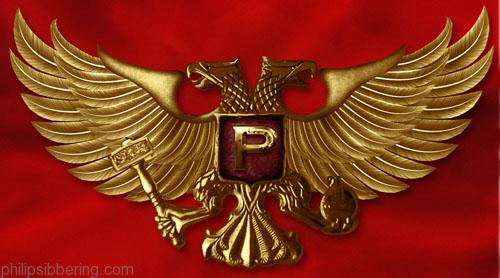 To make the distinction between Philverse and Philhammer clear: I'll be referring to my revision of Warhammer as Philhammer. There will be no separate website for 'Philhammer' as it contains GW IP. I'll be updating the articles, and filling out some of the missing details. I have to catch up on a fair bit of background. Philhammer covers the hidden science of 40K, the effects of the Dark Age of Technology has on contemporary Imperial design and culture, and attempt to explain how the 'grimdark' background can make sense to a modern, sceptical, tech-savvy, audience. In grounding 40K in reality, and explaining warp based technologies, it makes it easier to suspend your disbelief - or at least that is my aim.
To make the distinction between Philverse and Philhammer clear: I'll be referring to my revision of Warhammer as Philhammer. There will be no separate website for 'Philhammer' as it contains GW IP. I'll be updating the articles, and filling out some of the missing details. I have to catch up on a fair bit of background. Philhammer covers the hidden science of 40K, the effects of the Dark Age of Technology has on contemporary Imperial design and culture, and attempt to explain how the 'grimdark' background can make sense to a modern, sceptical, tech-savvy, audience. In grounding 40K in reality, and explaining warp based technologies, it makes it easier to suspend your disbelief - or at least that is my aim.
Sciror
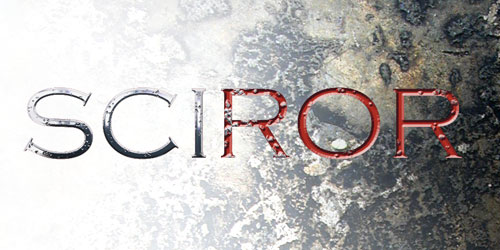 It was pointed out to me by other fans that because 'Philhammer' has so many of my ideas supporting it, that it had become its own setting. So I decided to run with it and develop a background-setting using all the ideas of Philhammer, ripping out all the GW IP, and see what happens. Thus Sciror was created. At its heart, it is a drop in 'replacement' setting for the 'Dark Age of Technology' from 40K but seen from the other side of history and the more positive perspective of the 'Golden Age of Technology'. It details the civilisation before the fall, why the fall happened, and the effects of the fall.
It was pointed out to me by other fans that because 'Philhammer' has so many of my ideas supporting it, that it had become its own setting. So I decided to run with it and develop a background-setting using all the ideas of Philhammer, ripping out all the GW IP, and see what happens. Thus Sciror was created. At its heart, it is a drop in 'replacement' setting for the 'Dark Age of Technology' from 40K but seen from the other side of history and the more positive perspective of the 'Golden Age of Technology'. It details the civilisation before the fall, why the fall happened, and the effects of the fall.
The fall comes about when the machines of the Supremacy leave humanity to their fate after the 'Psidemic' (world altering psionic manifestations). It replaces the popular trope of 'machine betrays man', from films such as Terminator, with 'man betrays machine' (there still isn't the exact tv trope - suggestions in the comment if you have one?).
Things get complicated: In working up this background I realised that: if Sciror could explain 40K tech, then it could explain any sci-fi. A lot of other sci-fi has the same issues as 40K, and I figure other creatives may encounter similar problems while creating their own worlds. So I then changed the concept of Sciror to 'meta-framework' for creating backgrounds. Anyone can create their own background for their setting using Sciror as a springboard for their vision. All the technology is explainable, interoperable, and you can concentrate on the story. If a fan of your narrative wants to know how something actually works, from their modern-day perspective, Sciror explains it. Sciror will still detail human advancement over the centuries, but it's stable, a 'vanilla' core of logical exploration of ideas about the future. All the action happens in scenarios branching off from this core, where events like The Fall become a 'what if'. Here are the 'what ifs' that will serve as an example of backgrounds created with Sciror: 'Stare in the Abyss', 'Psidemic' (The Fall) and 'Twistasy', which I'll be jumping between in a chaotic manner during development.
Displacement Point: The idea of Sciror is to create a 'displacement point'. Instead of using the modern world as our frame of reference, we move our perspective to an imagined point in the future and use that as a basis for storytelling. I think this can work as we live in stories, our perception of the world is a narrative, and we have so many stories through modern media that we can imagine a future world much more easily than in the past. More importantly, when we think of a setting that is incomplete, we quickly fix it by borrowing from other settings to fill in the gaps. This natural ability, and wealth of resource material, means we can create a common 'dreamscape'. A place where all stories come together, and interact with each other, using our common culture. Then we can start designing new stories taking this new 'reality' into account. It will create an unusual situation that if you know 'Sciror', the stories will make sense: in the same way traditional sci-fi references our world, this new sci-fi will reference Sciror. Stories based on stories. Using fiction as a basis for future imagineering. If you do not know Sciror, then it is probably going to be a culture shock as everything is different, and I want to make it different.
Visions of the Near Future
Here I'll be designing and imagining solutions to today's problems. Which will act as a springboard for Sciror. These solutions create the base narrative, the foundation, onto which I'll raise Sciror. By designing for the 'here and now', we can create narratives that are restrained by reality, and hence more believable. Anyone can judge the designs and see if they accept them. For example, if I design hab-unit: you can quickly decide if you would want to live there or not. If you do, and you think the design is a good idea, then you are 'hooked'. Then it's time to reel you in. Once your logic accepts the premise, it is much harder to put the brakes on, and then we are on the Philverse train to the future. At least that is the plan.
This all means you can start at Philhammer and follow the logic, and narrative, all the way back through history and end up in the here and now: looking at designs for our modern world. The reverse will also be true, that you can start from here and end up in 40K. I mentioned hab-units, and I think that is the first thing to tackle, as living space is so personal. You will know if you like it or not. I'll post my stages of Ecorium development, as this spans all era, and see how it takes. Will it hook?
Alphabetical listing for 1,000 chapter project
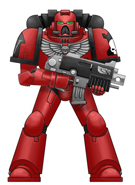
I've added alphabetical listing to the one thousand chapter project. Now you can quickly sort through all the chapters. I've also threw in first and second foundings on the canon listing. Since I've been away, GW has released a lot more information about many of the canon chapters found in the gallery, along with some new chapters (which I'll be adding). I'll be working through them all in my spare time, creating all the new images, which is time consuming so it may take a while. I've already sneaked in a couple of updates, adding in bolters for chapters we now know the bolter colours of. I'll post an update here for the canon chapters once done: a little mini-gallery of all the new chapters and changes made. In the meantime here is the Crimson Castellans, an update for one of the 'blanks'.
After that, I'll ask the mods over on Bolter and Chainsword to re-open the old submission thread. If they cannot do that I'll sort out a submission form here. Then I'll be able to take on new chapter submissions - I'm sure the Space Marine fans have been very busy while I've been away!
Back again
It's been a couple of years since I last posted on my blog. I had to step away due to family commitments. Now that my role as a carer is coming to an end, I find myself thinking about Philverse, Sciror, and WarSpike more and more. Lots of ideas have been running around in the back of my head while I've been away, no matter how much I tried to suppress them, and they are starting to bubble up to the surface. They need to be expressed; otherwise I'll explode, so I've starting to work them up.
As part of my Near Future designs, the first stepping stone of the Sciror timeline, I want to touch upon architecture, psychology and politics. Before I went on hiatus I started to think about these things, and how to lay a foundation unto which I build and justify the setting. My CORR housing post was my first outline of how to deal with a housing crisis in Britain, and how to build on the green belt land. I rendered up this image a couple of years ago;

These are 1-bed CORR hab-units, around 50 sq.m. (current UK minimum), along with a garden, built over the road, with commercial space inside, and parks outside. Using the real world as a basis for the design constraints the solutions, and forces creative thought. In being designed for real-world situations, they can be judged by anyone, and if they seem reasonable, they will be more believable. The idea is to make it easier to suspend disbelief and draw the reader in. We can then use these as a springboard for future developments, as it all leads to the Ecoria concepts. The nuke proof Ecoria are an extreme idea, they can be hard to accept, so I want to show the steps of how we get there.
Read the rest of this entry »The Machine Economy
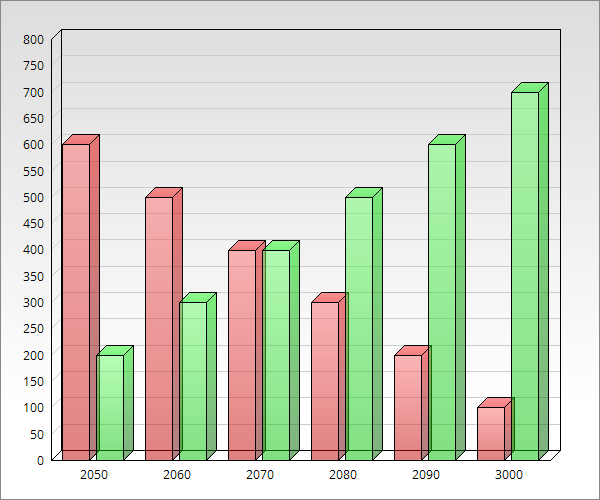
Business is stuck in the mindset that if you cut the pay of your workforce: you gain a competitive edge (as you can reduce costs). Which is true. This usually happens during an economic downturn with an increase in labour. However, as soon as all businesses follow suit you lose this competitive edge. The problem with this stratagem is that the workforce are also customers. When you cut the pay of your workers: you are also cutting the amount of money customers have to spend. This will lead to a decline the economy. What was once a sneaky ruse to gain an edge (which worked so well in the beginning) ends up as 'standard practice'. Which unfortunately leads to the whole system degrading. It then becomes very hard to buck this downward trend. If a decent company decides to pay good wages this will increase the money their workforce has to spend. This, in turn, will increase customer demand. But often this demand will be for other company's goods. (Unless the workforce spend all their money with their employer!) If other companies do not follow suit: the decent company will end up in trouble. (As the cost of its products increase.) In reality, this rarely happens: hence to battle the downward spiral we have the 'Minimum Wage'.
Businesses now have enough experience to realise they cannot get out of the wage reduction drive. Even with government intervention on the minimum wage, business always looking for the next way to cut costs and regain the edge. (Gain an edge for a short while until everyone else cottons on.) This is where the idea of out-sourcing, moving manufacturing to other countries, comes into play. Taking advantage of the lower cost of living in a developing country to reduce costs relative to the original country. The problem is the same as before: soon everyone does it, and their competitive edge. But now the company is paying workers in another country, and the customer base in the original country shrinks further. To further compound the suffering: the government (of the original country) does not receive any tax from workers in far away lands. Combined with the loss of jobs in the original country, shrinking VAT income from sales as the customer base collapses, along with increased benefits payment, leads to the whole lot heading on a downwards spiral.
Read the rest of this entry »
